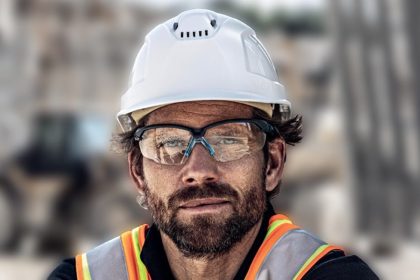Australia’s world-first ban on engineered stone took effect Monday, saving the lives of thousands of future Aussie construction workers from deadly dust diseases.
The harmful benchtop product has been finally outlawed after years of campaigning from Australia’s unions, who have witnessed the building material decimate the lives of hundreds of tradies every single year.
The ban, which took effect on July 1st, was the final nail in the coffin for artificial stone, which had faced mounting industry-imposed sanctions restricting its importation, sale, and use.
Prior to its outlawing, Aussie retailers had already banned the engineered stone from their shelves, and unions had stopped it from being imported or brought onto job sites. At the same time, growing numbers of construction companies and property developers refused to use it for building projects.
But the nationwide state government banning order, effective as of Monday, was the final domino to fall after years of significant pressure on politicians and businesses and a sustained public education campaign.
Construction, Forestry and Maritime Employees Union (CFMEU) National Secretary Zach Smith says the government ban was a momentous day for workers.
“Our union has stopped the asbestos of the 2020s in its tracks,” he said.
“This ban will save lives and protect workers’ families and friends from enduring more senseless deaths.”
Mr Smith says seeing the ban come into practice this week was great news for all those who campaigned, including union members, workers and engineered stone victims.
“This is a once-in-a-generation moment for workplace health and safety, only made possible by the sheer bravery of union members,” he said.
“No individual deserves more credit than Kyle Goodwin, a former stonemason with silicosis who has dedicated himself to ensuring no other workers receive a death sentence like he has.”
“CFMEU members stood up to evil businesses profiting from the deaths of workers – and won.”
Typically installed throughout Aussie kitchens and bathrooms, the manufactured benchtop stone has been long scrutinised after being linked to the debilitating lung condition – silicosis.
Nicknamed “the new asbestosis”, silicosis is caused by breathing the ultra-fine silica dust produced while cutting the stone, with estimates that 100,000 tradies will develop the condition in their lifetime.
Heavy fines await for ban dodgers
Prior to the materials ban, state-by-state national watchdogs imposed strict regulations on how the product was handled and used, with shortcuts resulting in heavy fines and convictions.
Just last month, Build-it revealed that one of Victoria’s largest industrial material processing companies, Sibelco, was fined more than $400,000 after several workers contracted silicosis due to lax safety measures.
Meanwhile, engineered stone provider Edstein Creative was fined $375,000 in May after it failed to minimise exposure to airborne respirable crystalline silica.
This continued rise in silicosis cases has led to a groundswell among campaigners calling for further safety protocols, worker support and legal consequences in remaining silica contact industries.
As for engineered Stone, the CFMEU says a similar legal fate awaits businesses that choose to ignore the ban.
“While this is undoubtedly a day to celebrate, I want to send a clear warning that the CFMEU will be watching like hawks for any company, employer or individual trying to get around this ban,” Mr Smith said.
SafeWork NSW also recently announced that it was stepping up enforcement efforts with more site visits and stricter penalties for non-compliant workplaces.
Meanwhile, WorkSafe Victoria Executive Director of Health and Safety Sam Jenkin said inspectors would be out in force to ensure total compliance with the ban.
“From today, WorkSafe’s silica enforcement team will be visiting manufacturers and processors – including unannounced visits – to ensure the products they are working with are permitted under the new regulations,” Mr Jenkin said.
“Inspectors will expect duty holders to be able to provide relevant information about the products they are working with and may take offcut samples for testing to determine if a product is engineered stone.”
July 1st changes to engineered stone regulations
The new regulations prevent the manufacturing, sale and use of engineered stone.
For the purpose of the ban, engineered stone is defined as an artificial product containing one per cent or more crystalline silica, created by combining natural stone with water, resins, or pigments that become hardened.
Concrete or cement products, bricks or pavers, ceramic wall or floor tiles, roof tiles, grout, mortar, render or plasterboard, or porcelain or sintered stone products that don’t contain resin are excluded from any regulatory changes.
Meanwhile, an exception to the prohibition will allow the removal, repair or modification of engineered stone benchtops, panels, or slabs to be installed before 1 July.
Some states are permitting the supply of engineered stone to other jurisdictions if that region still has a transition period in place.
Ban approval is not universal
Despite the ban’s majority support from both institutions and workers, some construction firms and tradies have described the total outlawing of the product as “regulatory overkill.”
Caesarstone, a national supplier and global manufacturer of engineered stone, previously launched an advertising campaign against any blanket ban, stating it would be “unnecessary and excessive”.
In a letter to Workplace Relations Minister Tony Burke, Caesarstone Australia managing director David Cullen warned a total ban would turn tradies towards more hazardous benchtop products.
“We believe such action may actually increase risks for workers, who will continue to handle types of stone containing levels of harmful silica higher – sometimes significantly – than the engineered stone products now available,” he said.
Build-it also spoke to builder and director of luxury home construction firm The Home Establishment, who says a blanket ban was a lazy solution to a problem that would still negatively affect engineered stone workers by costing jobs and leading to company collapses.

“There are many ways to cut this stone, and with more focus on worker protection from silica exposure and a multi-layered approach, it can be safe,” she explained to Build-it.
Shani says greater compliance with safety regulations, control methods, and safe work practices, such as on-tool water suppression, dust extraction devices and respiratory protection equipment, could have minimised dust generation and allowed the product to remain on the market while ensuring greater worker safety.
“People are still confused on if they can use what they have in the country already. I also have thoughts on the improper cutting of stone, which should have been looked at closer for review, rather than just a ban on Silica.”




